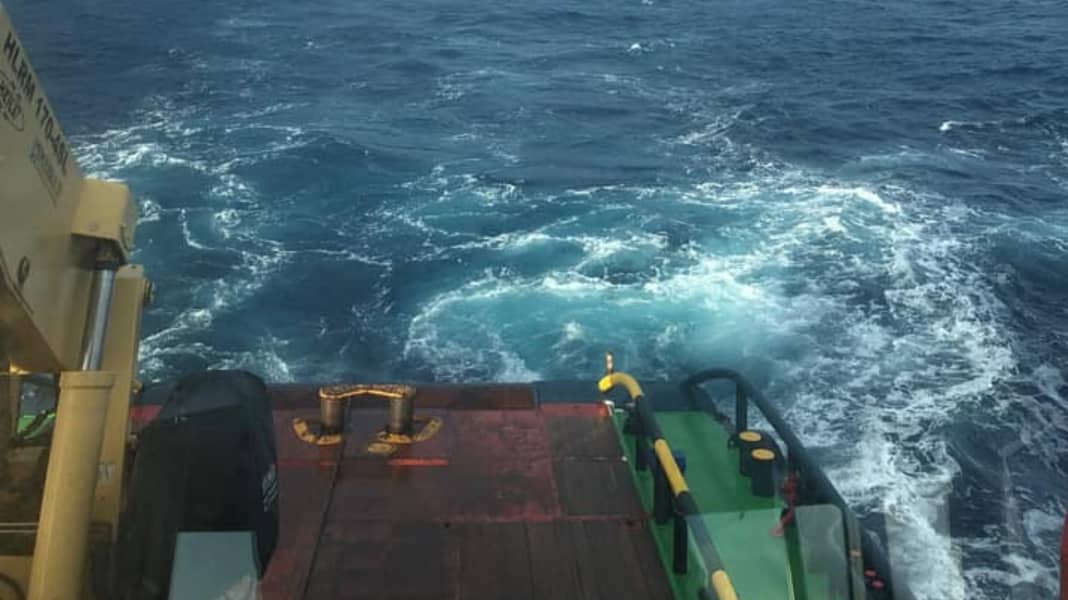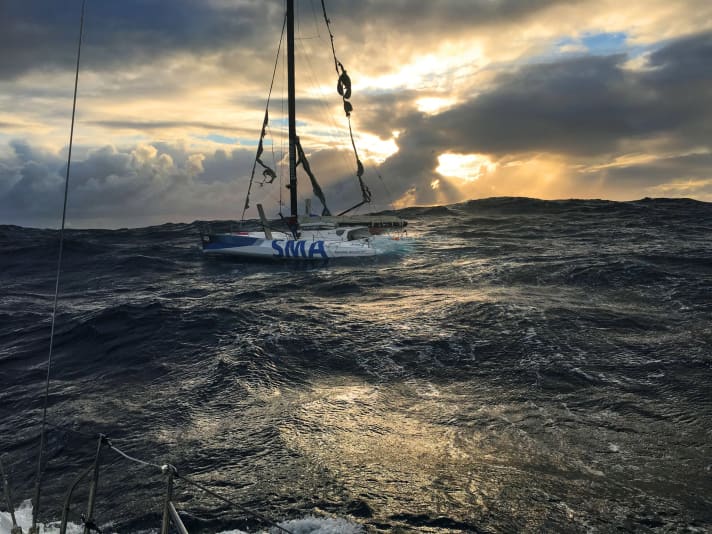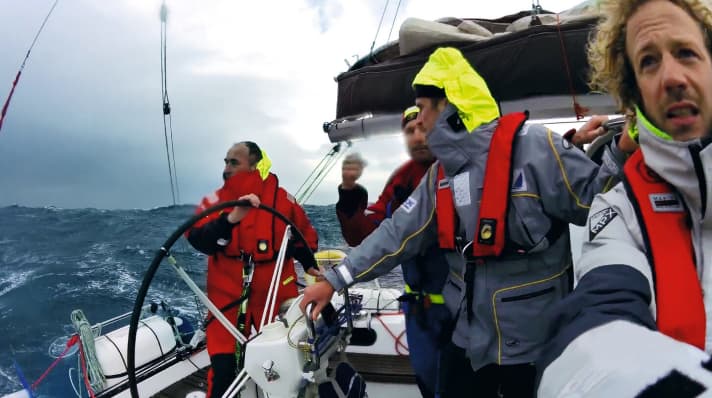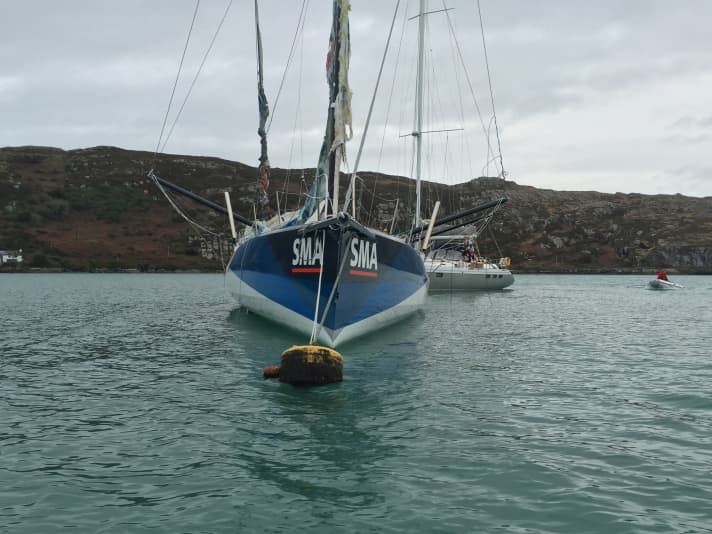
The picture is conciliatory: in the glow of a rainbow, a sailing yacht follows a commercial vessel. The scene was taken by Jello Sunfield. He is the captain of a shipping company and lives in Rostock. He posted the photo on Facebook as a comment on an article on YACHT online about ghost ships. Underneath, he noted: "I rescued one of the ARC ships, so it's no longer drifting in the Atlantic."
In the article, we clarified who actually owns a ship adrift at sea, whether you can keep it if you find it, and whether the crew is still liable for their boat even after it has been recovered. The answers are more than surprising for quite a few people.
No fewer than three ships were abandoned during the most recent transatlantic rallies organised annually by the World Cruising Club, two during the regular ARC and one during ARC January, which took place for the first time this year. On one ship, a crew member had suffered a fatal accident, while the other two crews had reported serious damage to their steering gear. In all three cases, the boats were abandoned and left to their own devices for the time being. However, two of the boats were equipped with transmitters so that their position remained known.
In addition to one of the first two casualties, the "Brainstorm" was also salvaged a few days ago. The X4.9 yacht was brought back to the starting harbour in Las Palmas de Gran Canaria by a tugboat. The insurance company had organised the salvage operation after it had become clear from the position reports that the yacht would apparently not sink so quickly despite the ingress of water. The Dutch crew, for their part, had been picked up by other rally participants; they have since arrived safely in the Caribbean - and are probably delighted with the successful rescue of their ship.
The following report on the abandoned Open 60 "SMA" and its 22-day drift on the North Atlantic shows just how spectacular such a rescue can be. It was a crazy rescue operation, carried out by true ghostbusters at sea - men who make the impossible possible.
An unmanned racing yacht is adrift on the Atlantic, half-sunk and exposed to brutal winter storms for weeks. Nobody manages to save her. Until a specialist for impossible tasks takes on the job.
When the wrecked yacht comes into view in the early afternoon of 4 January 2016, Adrien Hardy is relieved despite the miserable sight. Remnants of sails flutter like tattered rags in the rigging, the stern seems to be sinking. Again and again, the racing projectile for ocean racing with the inscription "SMA" disappears behind a grey crest of waves, only to rise up with its bow into nothingness shortly afterwards and then plunge again into the six-metre-deep valley. The Open 60, in which Frenchman François Gabart won the 2012/13 Vendée Globe in record time, is now nothing more than a helpless toy in the stormy seas. Hardy's biggest worry, however, seems unfounded: The mast is standing and the hull looks intact.
Even though it may seem extremely risky, the French skipper knows at this moment that he has to get over there if he wants to successfully complete his mission: to salvage the ship. Situations like this are typical of his job: Hardy collects abandoned yachts on the world's oceans and brings them back to land. Now he wears a survival suit and informs his client by telephone that the actual salvage operation is about to begin. His crew then manoeuvres their own yacht so skilfully close to the abandoned "SMA" that Hardy can cross over with the rubber dinghy.

On board, there is the kind of devastation you would expect on a ghost ship that has been drifting from winter storm to winter storm across the North Atlantic Ocean for three weeks without a skipper. Due to the open companionway, the water below deck is knee-deep, the forestay is damaged and the entire rig is at risk. Hardy secures it and begins to hoist - an arduous task without a functioning pump, especially as the weather continues to deteriorate and darkness sets in. Despite everything, Hardy decides to stay on board the "SMA" overnight; he doesn't want to risk losing the ship. "The night was a bit hard and long," Hardy will later say in his calm, unagitated manner, knowing that he is vastly understating the case.
The salvage operation took 22 DAYS from the first phone call on 16 December to the handover of the "SMA" on 6 January.
Three weeks before these events on the North Atlantic, 32-year-old professional skipper Adrien Hardy suspects that he will not be spending a peaceful Christmas with his family when the phone rings and Olivier de Roffignac answers. Roffignac is head of the claims department at yacht insurer Pantaenius in Monaco and always calls when a customer's boat needs to be rescued from a tricky situation. On this morning of 16 December, however, he initially only needs Hardy's assessment: south of the Azores, the Open 60 "SMA" has been drifting unmanned since the previous day, after its skipper Paul Meilhat was thrown against the forestay by high seas during a repair on the forecastle and had to be taken off with pelvic and rib fractures.
Meilhat was sailing the St. Barth-Port-la-Forêt transatlantic race from the Caribbean to France. It had started on 6 December 2015 in the Caribbean and was part of his qualification for the Vendée Globe 2016/17. The accident meant that the 34-year-old Meilhat, who like Adrien Hardy is one of those sailing-mad Frenchmen from the Atlantic coast who live for and from their sport, had to retire from the race, which was not only physically painful. Following Meilhat's removal by Portuguese rescue services, the insurer of the Open 60 and the French owner (Michel Desjoyeaux's racing team, appropriately named Mer Agitée - stormy sea) are now examining the salvage options for the "SMA" in parallel.
"Olivier de Roffignac wanted my opinion on the drift and the weather forecast, as I've recovered yachts on his behalf before," explains Hardy, who has made a good name for himself in this business with his unconventional but efficient methods. But his help is not needed for the time being; that very evening, the ocean-going tug "Tsavliris Hellas" leaves Ponta Delgada in the Azores with the "SMA" shore crew flown in to capture the Imoca. Less than 24 hours later, however, the tug gave up the chase: Under the makeshift mainsail salvaged from the injured Meilhat, the "SMA" is travelling north at up to five knots and the wind is gale-force, with a tendency to increase.
The crew received 21 WARNINGS of storm, including three of gale-force winds. She weathered in the harbour for six days
Hardy's phone rings again, Roffignac now asks specifically whether the specialist sees any possibility of salvaging the yacht. Others would have declined with thanks, pointing to the upcoming feast and the height of the waves on the Atlantic. But not the successful single-handed sailor, who had set off three days after the birth of his second son to rescue a Mini on the Atlantic.
He agrees and starts calling his list of 30 or so sea-tested warhorses and professional sailors that he trusts and relies on for requests of this kind. They are all men who stay calm when things get hairy outside and who love this kind of action, which Hardy describes as "a bit fresh". "Everyone on board earns the same, that's important for motivation, as is the bonus that comes with success," says Hardy, whose grandfather was a sailor and yachtsman. He finds four experienced colleagues who are also prepared to swap the warmth of the living room for the bitter realities of the Atlantic.

Adrien Hardy finds a suitable boat for the job in the port of Le Crouesty, a few kilometres south of his home in Auray: it is the "Galea", a 49-foot aluminium sailing yacht that a friend lends him. His requirements for a "lifeboat" are simple: "It should be solid and in good condition, as well as a fast, good sailor with the lowest possible entry at the stern," says Hardy. He always knows someone with a boat if he needs one. Or he knows someone who knows someone. Hardy and his crew are ready to set sail the next day.
The "Galea" travelled 2400 nautical miles, the "SMA" drifted 1100 nautical miles from the Azores towards the Irish coast
But then comes the cancellation: the "SMA" crew themselves want to try again with motorised help, this time from the northern Spanish coast. "End of Stand-By" is written in Hardy's salvage report. End of the day.
But the "Jif Xplorer" also breaks off early. The continued high speed of the "SMA", which was now drifting north-east and several hundred nautical miles away, the heavy weather and probably also the fact that the crew of the hastily chartered "Jif Xplorer" could think of more pleasant things than spending the festive season on the choppy ocean for a damaged racing yacht, meant that salvage attempt number two ended in La Coruña on 21 December. At around 6 p.m. the following day, Roffignac calls Hardy again, this time giving him the green light. He is his last hope.
The young Frenchman gets his team together again. "Organising everything at such short notice and right before Christmas was the big challenge with this rescue," he says. "What was easy, however, was that it started right on our doorstep." One day before Christmas Eve, just over a week after Paul Meilhat's fatal accident, the "Galea" leaves its home port heading west. The "SMA's" AIS has stopped transmitting its position and Hardy's crew only receives it via the tracker attached to the stern. At the time, the racing yacht is drifting 800 nautical miles east of the French coast. Hardy calculates that he will catch up with her within five days.
On board are New Zealander Chris Sayer, Frenchmen Brendan Boju and Olivier Hielle and Irishman Tom Dolan. All are ocean professionals and men of the sea, aged between 35 and 50. Their skipper, Hardy, is the baby of the rescue team, which also includes his father and the specially hired weather professional Christian Dumard, who maintain contact with the sailors from the mainland and provide the meteorological forecasts. But they promise an even stronger storm.

Three days after setting sail, Hardy estimated the chances of success at only 20 per cent, and the risk for the crew became too great - he aborted. Instead of reaching the "SMA" on 28th December, the "Galea" arrived in Brest to wait out the heavy weather and prepare for the next attempt. "We didn't want to have a second boat with a total loss," says Hardy, explaining the decision to pull out. A wise decision: Outside, where the racing yacht is drifting, the wind is blowing at over 60 knots and the waves are 14 metres high. Even the ferries across the English Channel have cancelled their service.
35 KNOTS was the average wind speed in the area during the deployment period (8 Beaufort)
The new strategy was to sail first to Ireland and from there towards the "SMA" drifting north-eastwards. "We couldn't wait forever, the time factor played a decisive role," says Hardy in retrospect. "The 'SMA' could have collided with a ship or object and sunk, or the positioning beacon at the stern could have stopped working." On the morning of 31 December, the five men leave the port of Brest with the "Galea".
As they cross the English Channel on their way to Ireland, they witness how quickly an emergency can occur in the still brutal conditions: They receive the mayday call from a container ship - man overboard! The hours that followed were devoted to searching for the man who had fallen overboard, who was eventually rescued by a helicopter but did not survive the accident. Even without the dramatic incident, Hardy's crew would have taken their mission very seriously: For the worst-case scenario, they train MOB manoeuvres with the boss in a survival suit as the victim.
The crew heads for Crookhaven, a nest on the south-western tip of Ireland, where the Atlantic meets the coast unchecked. There's not much there; green hills, a few houses, a single pub. The decisive factor for the "Galea" crew is the sheltered bay with buoys and plenty of space. Their skipper knows the place and knows that it is ideal for bringing the difficult-to-manoeuvre Open 60 here in the event of success. The aluminium yacht reaches its destination on 2 January, where the small salvage team sounds out the water depths and determines a mooring buoy for the "SMA". The next day, the weather forecast announces decreasing winds. Hardy estimates their chances of success at 70 per cent. The team sets sail.
A good 150 nautical miles off the coast, "Galea" finally meets up with the rest of the regatta yacht on 4 January 2016. Adrien Hardy's long night in the creaking, pitch-black hull takes its course. The "Galea" remains in close proximity without interruption; every two hours, the crew is in radio contact with Hardy, who nods every 20 minutes before cleaning out the steadily rising water with a bucket.
The cruising yacht is not the only one orbiting Hardy and the "SMA": The Shore crew of the "SMA" team have also travelled to Ireland to make a third attempt by tugboat from there. In the early hours of 5 January, as Hardy's night watch gradually draws to a close, the "Ocean Bank" arrives on the scene. Hardy refuses help via VHF - he wants to bring the Open 60 home in his own way.
The average height of the waves during the operation was 6 METRES, including much higher breakers
The next morning, his colleague Chris Sayer arrives on board the "SMA" using a life raft with hoses and a pump from the "Galea", which had been provided for this purpose. Hardy estimates that in the following six hours they have removed a good 15 tonnes of water from the hull. The two men set the smallest available cloth, a bright red storm sail; they don't want to put any more strain on the rigging. "The mast was very fragile," says Hardy, for whom it is important that damaged boats do not suffer further damage during salvage.

A good 24 hours after setting foot on board for the first time, he sets course for Ireland under his own steam with Sayer and the demolished but sailable "SMA". The sea is still rolling in with five-metre waves, but the 25 knots from the west are pushing them in exactly the right direction at a speed of five knots. Only when the wind dies down does the 14-metre-long "Galea", which escorts the "SMA" at maximum intervals of two nautical miles, take the 60-footer in tow. Under engine power, the unusual team covers the last 30 nautical miles. It's high time, the next storm is approaching.
On 6 January - exactly one month after "SMA" skipper Paul Meilhat set off from St. Barth for the Transat - his ship reaches Europe: the Imoca racer presents a picture of misery as it arrives in Crookhaven on the towline, which has now been shortened to 20 metres - but it floats. Hardy and Sayer moor the "SMA" to the buoy they had chosen five days earlier. The next call is to the phone, Hardy's call to Roffignac is due: Mission successfully completed.
The "SMA" team has now also arrived back in Crookhaven with the tugboat. Hardy hands the disabled vessel over to them and their job is done at this point. In the following days, the "SMA" team will move the Open 60 and get it afloat for the return journey to France, where a major overhaul is scheduled at the shipyard in parallel with Paul Meilhat's rehabilitation programme.

Adrien Hardy had no doubts about the success of his operation. "Nevertheless, I was proud that it worked. I was happy for the ship," he says. Nevertheless, the likeable Frenchman, who looks a little like Superman being deflated in his red and blue survival suit, was close to his limit: "The 'SMA' was the biggest challenge of my previous salvage operations. The level was okay, but it doesn't have to get any harder than that." That's what he says now. Until the phone rings again and the next special job is due.
YACHT: Why do you as an insurer rely on skippers like Adrien Hardy when it comes to salvaging sailing ships?
Roffignac: His method of using sailboats to recover other sailboats has several advantages: He operates quickly, independently, efficiently and is therefore cheaper; with him you do the right things immediately. I was also in favour of using Hardy in the "SMA" case. He has a solution for everything. Ask him how he righted a capsized Class 40 with the help of tide and air bodies. It was brilliant, but he would never brag about it.
How did the collaboration between the insurance company and Adrien Hardy come about?
At the Mini-Transat 2013, he recovered boats as a friendly service, which impressed me, and we approached him.
Who decides how a salvage operation is carried out - the owner or the insurance company?
Ideally, the decision is made by consensus (laughs). The most important thing, however, is that the insurance company has confidence in the rescuers and the skipper who is leading the venture.
How does the insurance of a regatta yacht differ from that of a cruising boat?
On yachts such as the Open 60, the mast, rig and sails are generally excluded from the insurance, as these are the parts of the yacht that are most likely to be damaged. If they were to be insured, it would be too expensive. The teams understand this and know that it is their risk. Regatta and cruising yachts also form separate risk groups with us, so that interactions with regard to the insurance premiums of the cruising sailors are excluded if something happens at an event like the Vendée.
Isn't it dangerous to send sailors into heavy weather to salvage a yacht?
Adrien Hardy and his fellow sailors know their trade, they are professionals. The fact that they turned back when the weather got too bad shows that they are not crazy.

